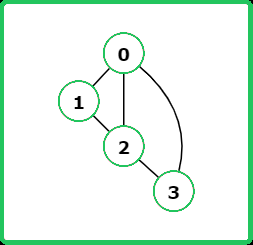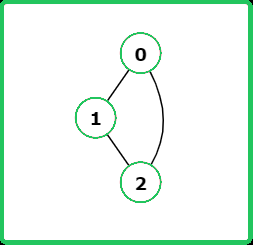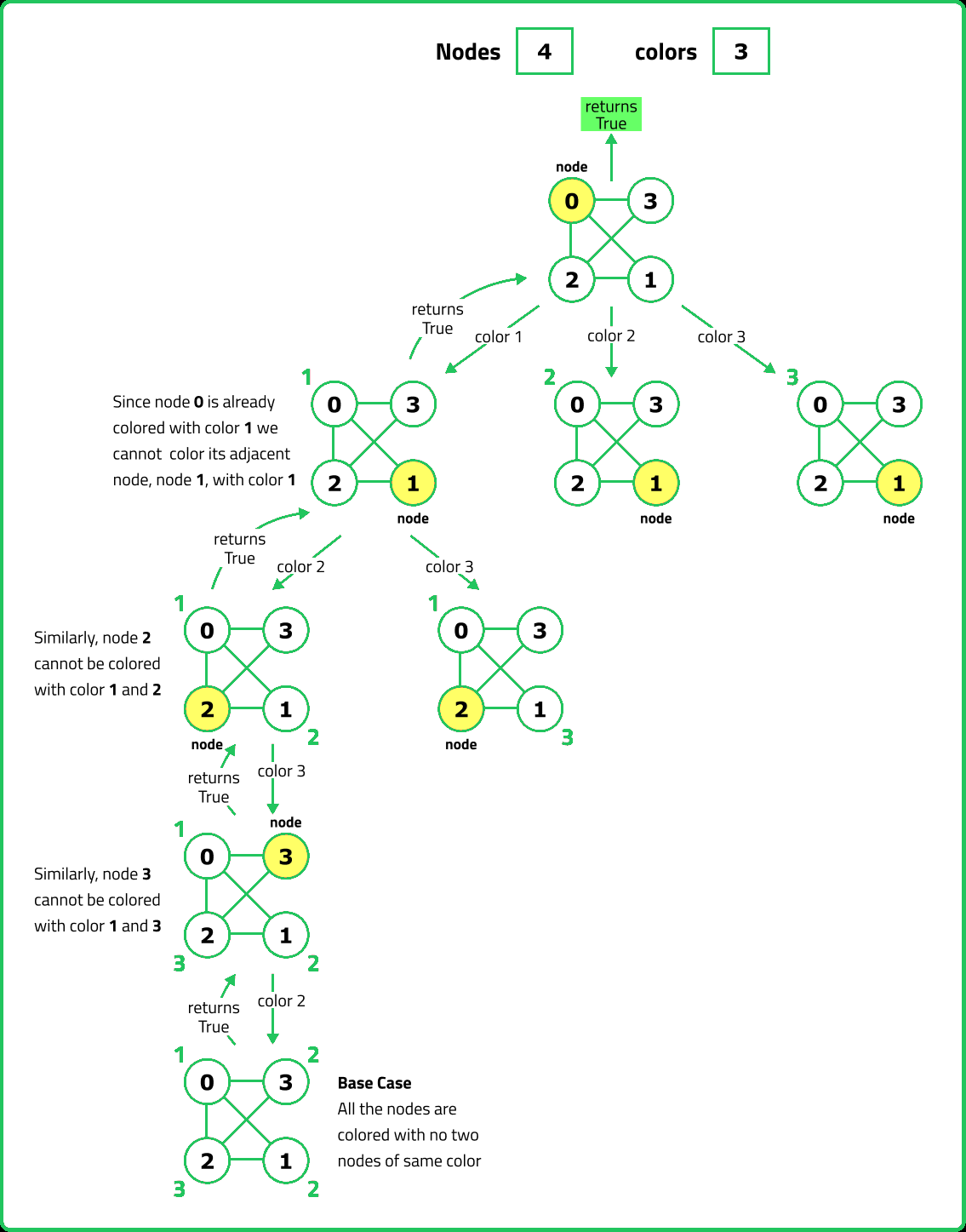1234567891011121314151617181920212223242526272829303132333435363738394041424344454647484950515253545556575859606162636465666768697071
#include bits/stdc++.h
using namespace std;
class Solution {
public:
// Function to check if it's safe to color the node with a given color
bool isSafe(int col, int node, vector<int>& colors, vector<int> adj[]) {
// Check adjacent nodes
for (int i = 0; i < adj[node].size(); i++) {
// If an adjacent node has the same color
if (colors[adj[node][i]] == col) return false;
}
return true; // Safe to color
}
// Recursive function to solve graph coloring problem
bool solve(int node, int m, int n, vector<int>& colors, vector<int> adj[]) {
// If all nodes are colored
if (n == node) return true;
// Try all colors from 1 to m
for (int i = 1; i <= m; i++) {
// Check if it is safe to color the node with color i
if (isSafe(i, node, colors, adj)) {
// Assign color i to node
colors[node] = i;
// Recursively try to color the next node
if (solve(node + 1, m, n, colors, adj)) return true;
// Reset color if it doesn't lead to a solution
colors[node] = 0;
}
}
// No color can be assigned
return false;
}
// Function to check if the graph can be colored with m colors
bool graphColoring(vector<vector<int>>& edges, int m, int n) {
// Adjacency list representation of the graph
vector<int> adj[n];
// Build the graph from edges
for (int i = 0; i < edges.size(); i++) {
adj[edges[i][0]].push_back(edges[i][1]);
adj[edges[i][1]].push_back(edges[i][0]);
}
// Initialize all colors to 0 (uncolored)
vector<int> colors(n, 0);
// Start solving from the first node
return solve(0, m, n, colors, adj);
}
};
int main() {
Solution sol;
vector<vector<int>> edges = {
{0, 1}, {0, 2}, {1, 2}, {1, 3}
};
int m = 3; // Number of colors
int n = 4; // Number of nodes
// Check if the graph can be colored with m colors
if (sol.graphColoring(edges, m, n)) {
cout << "The graph can be colored with " << m << " colors." << endl;
} else {
cout << "The graph cannot be colored with " << m << " colors." << endl;
}
return 0;
}
123456789101112131415161718192021222324252627282930313233343536373839404142434445464748495051525354555657585960616263646566
import java.util.*;
class Solution {
// Function to check if it's safe to color the node with a given color
private boolean isSafe(int col, int node, int[] colors, List<List<Integer>> adj) {
// Check adjacent nodes
for (int neighbor : adj.get(node)) {
// If an adjacent node has the same color
if (colors[neighbor] == col) return false;
}
return true; // Safe to color
}
// Recursive function to solve graph coloring problem
private boolean solve(int node, int m, int n, int[] colors, List<List<Integer>> adj) {
// If all nodes are colored
if (n == node) return true;
// Try all colors from 1 to m
for (int i = 1; i <= m; i++) {
// Check if it is safe to color the node with color i
if (isSafe(i, node, colors, adj)) {
colors[node] = i; // Assign color i to node
// Recursively try to color the next node
if (solve(node + 1, m, n, colors, adj)) return true;
colors[node] = 0; // Reset color if it doesn't lead to a solution
}
}
return false; // No color can be assigned
}
// Function to check if the graph can be colored with m colors
public boolean graphColoring(int[][] edges, int m, int n) {
// Create adjacency list representation of the graph
List<List<Integer>> adj = new ArrayList<>();
for (int i = 0; i < n; i++) {
adj.add(new ArrayList<>());
}
// Build the graph from edges
for (int[] edge : edges) {
adj.get(edge[0]).add(edge[1]);
adj.get(edge[1]).add(edge[0]);
}
int[] colors = new int[n]; // Initialize all colors to 0 (uncolored)
// Start solving from the first node
return solve(0, m, n, colors, adj);
}
public static void main(String[] args) {
Solution sol = new Solution();
int[][] edges = {
{0, 1}, {0, 2}, {1, 2}, {1, 3}
};
int m = 3; // Number of colors
int n = 4; // Number of nodes
// Check if the graph can be colored with m colors
if (sol.graphColoring(edges, m, n)) {
System.out.println("The graph can be colored with " + m + " colors.");
} else {
System.out.println("The graph cannot be colored with " + m + " colors.");
}
}
}
1234567891011121314151617181920212223242526272829303132333435363738394041424344454647484950515253
class Solution:
def isSafe(self, col, node, colors, adj):
# Function to check if it's safe to color the node with a given color
# Check adjacent nodes
for neighbor in adj[node]:
# If an adjacent node has the same color
if colors[neighbor] == col:
return False
return True # Safe to color
def solve(self, node, m, n, colors, adj):
# Recursive function to solve graph coloring problem
# If all nodes are colored
if n == node:
return True
# Try all colors from 1 to m
for i in range(1, m + 1):
# Check if it is safe to color the node with color i
if self.isSafe(i, node, colors, adj):
colors[node] = i # Assign color i to node
# Recursively try to color the next node
if self.solve(node + 1, m, n, colors, adj):
return True
colors[node] = 0 # Reset color if it doesn't lead to a solution
return False # No color can be assigned
def graphColoring(self, edges, m, n):
# Function to check if the graph can be colored with m colors
adj = [[] for _ in range(n)] # Create adjacency list representation of the graph
# Build the graph from edges
for edge in edges:
adj[edge[0]].append(edge[1])
adj[edge[1]].append(edge[0])
colors = [0] * n # Initialize all colors to 0 (uncolored)
# Start solving from the first node
return self.solve(0, m, n, colors, adj)
# Example usage
if __name__ == "__main__":
sol = Solution()
edges = [
[0, 1], [0, 2], [1, 2], [1, 3]
]
m = 3 # Number of colors
n = 4 # Number of nodes
# Check if the graph can be colored with m colors
if sol.graphColoring(edges, m, n):
print("The graph can be colored with", m, "colors.")
else:
print("The graph cannot be colored with", m, "colors.")
1234567891011121314151617181920212223242526272829303132333435363738394041424344454647484950515253545556575859
class Solution {
// Function to check if it's safe to color the node with a given color
isSafe(col, node, colors, adj) {
// Check adjacent nodes
for (let neighbor of adj[node]) {
// If an adjacent node has the same color
if (colors[neighbor] === col) return false;
}
return true; // Safe to color
}
// Recursive function to solve graph coloring problem
solve(node, m, n, colors, adj) {
// If all nodes are colored
if (n === node) return true;
// Try all colors from 1 to m
for (let i = 1; i <= m; i++) {
// Check if it is safe to color the node with color i
if (this.isSafe(i, node, colors, adj)) {
colors[node] = i; // Assign color i to node
// Recursively try to color the next node
if (this.solve(node + 1, m, n, colors, adj)) return true;
colors[node] = 0; // Reset color if it doesn't lead to a solution
}
}
return false; // No color can be assigned
}
// Function to check if the graph can be colored with m colors
graphColoring(edges, m, n) {
// Create adjacency list representation of the graph
let adj = Array.from({ length: n }, () => []);
// Build the graph from edges
for (let edge of edges) {
adj[edge[0]].push(edge[1]);
adj[edge[1]].push(edge[0]);
}
let colors = new Array(n).fill(0); // Initialize all colors to 0 (uncolored)
// Start solving from the first node
return this.solve(0, m, n, colors, adj);
}
}
// Example usage
const sol = new Solution();
const edges = [
[0, 1], [0, 2], [1, 2], [1, 3]
];
const m = 3; // Number of colors
const n = 4; // Number of nodes
// Check if the graph can be colored with m colors
if (sol.graphColoring(edges, m, n)) {
console.log("The graph can be colored with " + m + " colors.");
} else {
console.log("The graph cannot be colored with " + m + " colors.");
}


